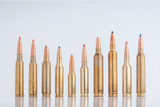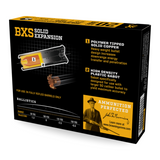Eb's Simplified Reloading Method
Eb's Simplified Reloading Method
Disclaimer: Reloading Ammunition Can be Dangerous. If You Choose to Reload Ammo, Do So At Your Own Risk.
by Eben Brown, E. Arthur Brown Company, Inc.
I think that in many cases, people will make reloading too complicated. By that I mean, they will use advanced reloading techniques without understanding how their particular firearm will respond. I decided to write this article and YouTube video to show you what I do to make my own reloaded ammo for the TC Encore, Contender, and Model 97D rifles.
Avoid Neck Sizing - Neck sizing is an advanced reloading technique that results in ammo that fits too tight. Amateurs can get away with it in bolt action rifles. But in TC Contenders and Encores, neck sizing causes incomplete lock-up that gets worse with each successive reloading. This causes inconsistent lock-up case head tension against the breech, which seriously hurts accuracy and degrades the margin of safety in the lock-up of the barrel to the frame. Nothing to gain and too much complication is caused by neck sizing - IMHO.
Remove Press Frame Flex - We recommend full length resizing your fired brass. But if you don't adjust your sizing die to compensate for the stretch or flex in your reloading press, you won't be getting the proper amount of full length resizing. Check to see if there is a gap between the bottom of your die and the shell holder when you are actually resizing your brass. If you see a gap, adjust the die and try again... Until there is no gap. This will make brass fit reliably and consistently.
Test Fit Your Resized Brass - Make sure it chambers, ejects, and functions freely in the gun you plan to shoot it in. There's no better way than to just try it out in your gun.
Clean and De-Grease - Fouling, oils, and solvents can make your ammunition fit poorly and function erratically. Poor fit can hurt accuracy, lock-up, and ejection/extraction. Oils and solvents can work like resizing lube in the chamber... Allowing cartridges to slide, brass to flow, and frames to flex during ignition. Cartridge Brass (and chamber) should be clean and dry so they'll fit and grip the chamber during ignition.
Trim and Chamfer - At least after the first firing. The main thing is to make each piece of brass the same as the other pieces. This gives the same fit and the same release tension to every shot. The other reason for trim to be sure your brass is not too long for your chamber. Check a cartridge drawing for that. Don't worry about neck turning... It's not worth the trouble. In our Free Tech Reports, See the Article on Trim Length.
Basic Priming - All you need is for your primers to be seated flush with the case head... So they'll fit your chamber reliably. Don't worry about primer pocket reaming, flash hole deburring and other advanced techniques... They're not worth the trouble.
Gun Powder - A powder "measure" dispenses a complete charge. You adjust it to the amount of powder desired. A powder "scale" is what weighs the charge in grains. I use a small electronic scale that calibrates and zeros itself. It's accurate to within +/-.1 grain. I check each charge before dumping the powder into the shell casing.
Bullet Seating - This is another area where advanced techniques can cause problems. Trying to seat bullets too close to the rifling can cause pressures to peak too fast. It can cause ammo fitting problems. It can even cause erratic head space tensioning problems and hurt accuracy.
Here's how I seat bullets: First, I put a dummy shell casing in the reloading press and pull down the handle. With the casing at the top of the reloading press stroke, I screw down the seating die. When it contacts the top of the shell casing, that's the crimp. I don't wish to crimp so I back the die up a half turn and lock it in place with the lock ring.
At the top of the die is the seating stem. I back the stem out quite a ways, then put a bullet on top of the shell casing an pull down the handle. When it contacts the seating stem, the bullet will be pushed into the shell casing. Adjust the seating stem down until you are able to seat a bullet part way into the shell casing. Now, test fit the dummy cartridge in your gun. If the bullet isn't seated deep enough, the dummy cartridge won't go all the way into the chamber.
Then, you adjust the seating stem a little further, seat the bullet a little further, and test fit the dummy cartridge again. Keep adjusting, seating, and testing fitting until your dummy cartridge fits completely into your chamber.
Remember, Weatherby became famous selling accurate magnum rifles with extremely long throats and bullet jump. Also, our Free Tech Reports have valuable articles: "Long Jump" Bullet Seating, and Cartridge Overall Length.
Working Up a Load - After determining a powder type and a starting load, assemble a cartridge and test fire it. Observe how the gun functions as you eject or extract the casing. Was there any increased difficulty in opening the action? Did the shell casing stick in the chamber? How flat is the primer? etc.
If all seems well, increase the charge by .5 grain and test fire again. Observe all of the above... Write it down. Increase the charge again and test fire. Observe again.
At the first sign of stickiness... Either in function or extraction, stop increasing. This is the maximum for the powder you are using. Now, charge another shell casing with that maximum charge and look inside to see how full it is. If the maximum charge does not fill the case to the bottom of the bullet, you may be able to work up a better load with a slower powder.
I like VihtaVuori powders because the Powder Numbers indicate the burn rate... The higher the number, the slower the powder. So, if a maximum load doesn't fill the case to the base of the bullet, trying a slower powder and working upward .5 grain at a time as described above... Watching for pressure signs.
I usually get my best accuracy along with my highest velocity when I use a powder that fills the case completely to the bottom of the bullet at the maximum powder charge.
Recent Posts
-
6.5mm Cartridge Comparison
6.5mm Cartridge Comparison (Pictorial Overview) A Quick Look at Popular 6.5mm Rifle Cartridges Vis …Aug 11th 2025 -
Rethinking Shotgun Slug Accuracy: Why Slower Might Be Better
Last year the Browning slugs I ended up using were a departure from conventional thinking but they …Jun 12th 2025 -
The Timeless Appeal of the .308 Winchester: Why This Cartridge Endures
The .308 Winchester, introduced in 1952, has become one of the most enduring cartridges in firearms …Jul 11th 2024


